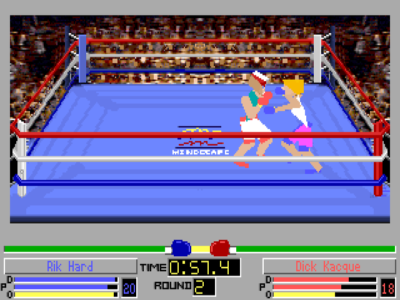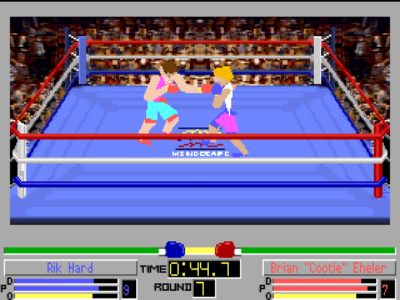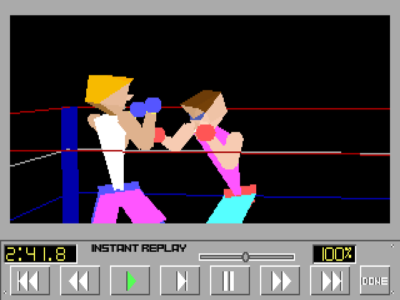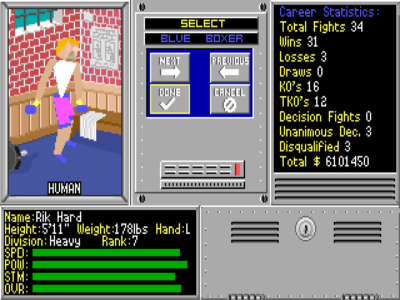
4D Sports: Boxing
Written by: Rik
Date posted: July 21, 2019
- Genre: Sport
- Developed by: Distinctive Software
- Published by: Mindscape
- Year released: 1991
- Our score: 5
Mindscape’s 4D Sports series was a strange beast: only three games, one of which doesn’t technically feature a sport. All were developed by Distinctive Software, later to become EA Canada, but it seems that the 4D branding was a concoction for European territories only, with the games existing in alternative formats and known by different titles elsewhere. In characteristically efficient fashion, our efforts to cover the complete series have taken roughly 18 years, an unnecessarily long-winded process that finally ends with coverage of this boxing game.
Whether conceived as a series or not, the 4D Sports games do all seem to share common DNA, evidenced through use of 3D polygon graphics and a full range of camera angles and replay options. First impressions are that this approach lends itself less well to boxing than other sports, with a combination of basic models and the natural mish-mash of bodies that occurs during a fight making it fairly hard at times to see what’s going on, regardless of which camera you select. Indeed, even with the sound effects giving you indications of impact and the various indicator bars at the bottom of the screen, it can be easy to get drawn into a brawl and take a lot of damage very quickly. Throw in a control scheme that’s rather more detailed than one might anticipate, and you find a game that isn’t quite so easy to get to grips with at first.
With a more serious investment of time, effort and consideration, these early concerns are – to an extent – overcome, without being dismissed entirely. After some fiddling with the different options, the default camera view seems to be the least problematic, and also benefits from a static 2D background which makes the whole thing slightly more aesthetically pleasing. Meanwhile, closer inspection of the controls reveals a rather advanced and (for the time) nuanced system, allowing a full range of movement as well as a wide selection of punches and blocks. Once you get used to it, it’s possible to get into a rhythm of movement and combinations in a way that is very satisfying.
In addition to the damage and power gauges (not explained even in the manual, although the top one seems to indicate how much more damage you can take immediately, the one in the middle how much power your own punches will pack, and the one at the bottom your boxer’s overall condition) there’s also an aid that shows how close you are to your opponent and whether that is within punching range, but you still need to take account of their relative positions and punch selection or you still might not make contact.
My experience of boxing games is limited to moderate tinkering with a couple of 00s EA Fight Night games, but I can certainly see the origins of the fundamentals of that series here in terms of the range of moves and options available, which is no mean feat for a game of this vintage. Unfortunately, while Fight Night was released in the era of the twin-stick joypad, 4D Sports: Boxing is from the time of the one button joystick, and as such the controls lack some of the precision required. The 8 direction buttons are used for movement around the ring as well as punch selection, which means that the former often bleeds into the latter, and even the block buttons also move your boxer at the same time.
Playing on keyboard, a second key may also be combined with one of the direction buttons to perform taunt/showoff moves, but these are largely unnecessary, and not something you’ll worry about unless you’re winning comfortably and want to, you know, show off (but who to? The imaginary crowd? Your imaginary friends?)
Options are fairly limited, outside of the multiple camera angles: there’s no difficulty setting, just an option to choose different AI levels (supposedly to save processor power, which isn’t a problem unless you’re still running a 286) and the number of rounds. Fight modes come down to a single exhibition match or a career event. The latter requires you to create your own puny boxer and build him or her up across a number of fights and gym sessions in order to progress to the top of the rankings. Between bouts, you can browse the ranks of AI boxers with pun-tastic names, select your opponent (as long as they’re within the immediate vicinity of your own ranking) and then choose what to focus on in the gym in terms of building up your stats for speed, power or stamina. Prize money is also allocated depending on the result and rank of your opponent.
The blurb for the game advertises a variety of foes not only with different stats but with different personalities and tactics, and advises you to use the replay feature to study these carefully after a defeat. My own knowledge of and interest in boxing is fairly limited, and like many peripheral fans of a sport who expect the action in a game to be boiled down to the most exciting parts no matter how much they might tell themselves they could develop an interest in the nuances and subtleties, I put a lot of my training time into power and expected to win every match by knockout, hitting the hooks and uppercuts hard at every opportunity.
For the vast majority of the game this strategy largely worked, and my only defeats came after having to quit in the middle of a bout or because the controls locked up and my fighter refused to move (often after having knocked an opponent to the floor then forfeiting the match after being unable to back away). At no point did I really notice much difference in fighting styles, only that opponents got progressively harder until they started beating me, and I was unable to get into the top 5.
Perhaps that was down to my own strategy or lack of skill, and I was punished at higher levels, where fights quickly descended into messy and futile slugfests, with any attempt at a more defensive approach only producing even worse results. By that point, my own stats were pretty much maxed out, and superior to those immediately above me, but I definitely felt I’d hit a spike. Fighters fell largely into two categories: those I could beat, and those I couldn’t – subtleties in-between were hard to detect. As you approach 40 fights or so, you start to get warnings that your boxer is getting old and in a few fights’ time will retire. At that point your cumulative prize money will represent your high score on the table, and you’ll have to start again with a new fighter at the bottom of the rankings.
And that’s about it. On the one hand there’s plenty to admire about 4D Sports: Boxing: it’s certainly more ambitious than a lot of sports games of the era, and when things are going well it can be quite satisfying. However, the simple graphics and limitations on controls are a problem from a practical point of view when it comes to this particular sport. Like its sister title, 4D Sports: Driving, 4DS: Boxing appears – based on anecdotal evidence from your correspondent’s moderate but long-running association with the scene – to have been a long-time abandonware stalwart, and beloved by many as a result. But overall I found it the least successful of the 4D games, although certainly not without its merits and enjoyable moments.






 Posts
Posts